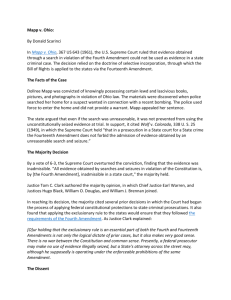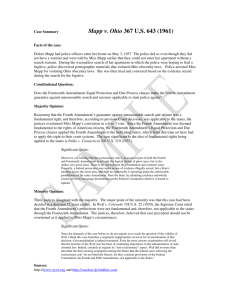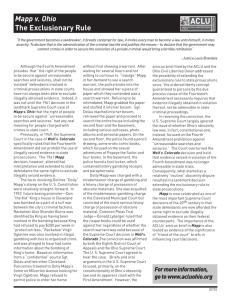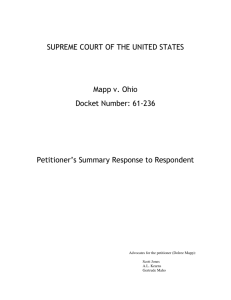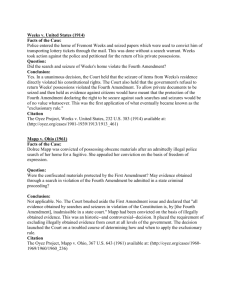Test Court Cases - Hatboro
advertisement
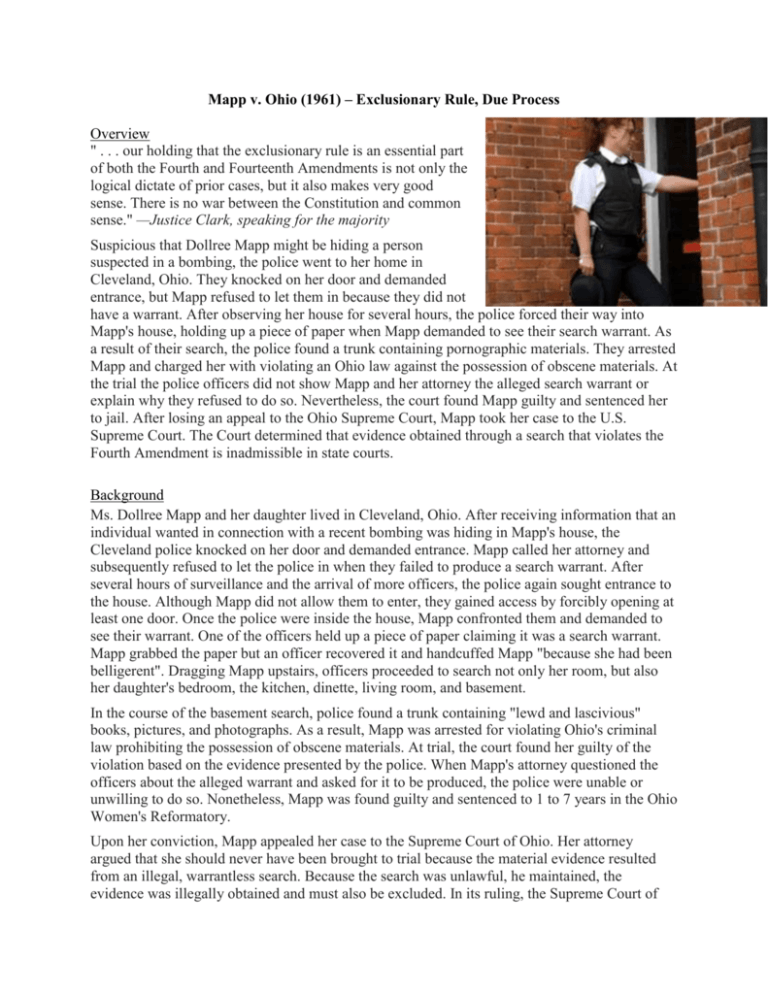
Mapp v. Ohio (1961) – Exclusionary Rule, Due Process Overview " . . . our holding that the exclusionary rule is an essential part of both the Fourth and Fourteenth Amendments is not only the logical dictate of prior cases, but it also makes very good sense. There is no war between the Constitution and common sense." —Justice Clark, speaking for the majority Suspicious that Dollree Mapp might be hiding a person suspected in a bombing, the police went to her home in Cleveland, Ohio. They knocked on her door and demanded entrance, but Mapp refused to let them in because they did not have a warrant. After observing her house for several hours, the police forced their way into Mapp's house, holding up a piece of paper when Mapp demanded to see their search warrant. As a result of their search, the police found a trunk containing pornographic materials. They arrested Mapp and charged her with violating an Ohio law against the possession of obscene materials. At the trial the police officers did not show Mapp and her attorney the alleged search warrant or explain why they refused to do so. Nevertheless, the court found Mapp guilty and sentenced her to jail. After losing an appeal to the Ohio Supreme Court, Mapp took her case to the U.S. Supreme Court. The Court determined that evidence obtained through a search that violates the Fourth Amendment is inadmissible in state courts. Background Ms. Dollree Mapp and her daughter lived in Cleveland, Ohio. After receiving information that an individual wanted in connection with a recent bombing was hiding in Mapp's house, the Cleveland police knocked on her door and demanded entrance. Mapp called her attorney and subsequently refused to let the police in when they failed to produce a search warrant. After several hours of surveillance and the arrival of more officers, the police again sought entrance to the house. Although Mapp did not allow them to enter, they gained access by forcibly opening at least one door. Once the police were inside the house, Mapp confronted them and demanded to see their warrant. One of the officers held up a piece of paper claiming it was a search warrant. Mapp grabbed the paper but an officer recovered it and handcuffed Mapp "because she had been belligerent". Dragging Mapp upstairs, officers proceeded to search not only her room, but also her daughter's bedroom, the kitchen, dinette, living room, and basement. In the course of the basement search, police found a trunk containing "lewd and lascivious" books, pictures, and photographs. As a result, Mapp was arrested for violating Ohio's criminal law prohibiting the possession of obscene materials. At trial, the court found her guilty of the violation based on the evidence presented by the police. When Mapp's attorney questioned the officers about the alleged warrant and asked for it to be produced, the police were unable or unwilling to do so. Nonetheless, Mapp was found guilty and sentenced to 1 to 7 years in the Ohio Women's Reformatory. Upon her conviction, Mapp appealed her case to the Supreme Court of Ohio. Her attorney argued that she should never have been brought to trial because the material evidence resulted from an illegal, warrantless search. Because the search was unlawful, he maintained, the evidence was illegally obtained and must also be excluded. In its ruling, the Supreme Court of Ohio recognized that "a reasonable argument" could be made that the conviction should be reversed "because the 'methods' employed to obtain the [evidence]. . . were such as to 'offend' a sense of justice." But the Court also stated that the materials were admissible evidence. The Court explained its ruling by differentiating between evidence that was peacefully seized from an inanimate object (the trunk) rather than forcibly seized from an individual. Based on this decision, Mapp's appeal was denied and her conviction upheld. Mapp appealed again to the Supreme Court of the United States. The case came down to this fundamental question: may evidence obtained through a search in violation of the Fourth Amendment be admissible in state criminal proceedings? The Fourth Amendment states "The right of the people to be secure in their persons, houses, papers, and effects, against unreasonable searches and seizures, shall not be violated, and no Warrants shall issue, but upon probable cause . . . and particularly describing the place to be searched, and the persons or things to be seized." The Fourth Amendment, however, does not define when a search or seizure is "unreasonable" nor does it specify how evidence obtained from an "unreasonable" search should be treated. While never previously addressing the specific question presented by Mapp's case, the Supreme Court of the United States had made attempts to determine what constitutes a reasonable search and what evidence can be used in court. It first wrestled with these issues in Boyd v. United States (1886) when the Court declared that "any forcible and compulsory extortion of a man's own . . . private papers to be used as evidence to convict him of a crime . . . is within the condemnation of . . . [the Fourth Amendment]. Later, in Weeks v. United States(1914), the Court ruled that the Fourth Amendment "put the courts of the United States and federal officials . . . under limitations . . . and forever secure[d] the people, their persons, houses, papers and effects against all unreasonable searches and seizures. . . ." By including only United States and federal officials in its ruling, however, the Court still left open the question of whether evidence unlawfully seized could be used in a state criminal court proceeding. In Wolf v. Colorado (1949) the Court for the first time discussed the effect of the Fourth Amendment on the states. It concluded that the Due Process Clause of the Fourteenth Amendment incorporated, or made applicable to the states, the Fourth Amendment to the Constitution. However, the ruling in Wolf also made clear that "in a prosecution in a State court for a State crime the Fourteenth Amendment does not forbid the admission of evidence obtained by an unreasonable search and seizure." In other words, the exclusionary rule did not apply to the states. Some states, including Ohio, felt that they should be able to make their own determination regarding the admissibility of illegally obtained evidence. Nevertheless, in 1960 the Supreme Court of the United States agreed to hear Mapp's case and reconsider the decision it had reached in Wolf by determining whether the U.S. Constitution prohibited state officials from using evidence obtained in violation of the Fourth Amendment. The decision in Mapp v. Ohio was handed down in 1961. New Jersey v. T.L.O. (1985) – Student Search and Seizure Overview ". . . The warrant requirement, in particular, is unsuited to the school environment . . . [T]he legality of a search of a student should depend simply on the reasonableness, under all the circumstances, of the search . . . Such a search will be permissible in its scope when the measures adopted are reasonably related to the objectives of the search and not excessively intrusive in light of the age and sex of the student and the nature of the infraction. "—Justice Byron White, speaking for the majority A New Jersey high school student was accused of violating school rules by smoking in the bathroom, leading an assistant principal to search her purse for cigarettes. The vice principal discovered marijuana and other items that implicated the student in dealing marijuana. The student tried to have the evidence from her purse suppressed, contending that mere possession of cigarettes was not a violation of school rules; therefore, a desire for evidence of smoking in the restroom did not justify the search. The Supreme Court decided that the search did not violate the Constitution and established more lenient standards for reasonableness in school searches. Background In 1980, a teacher at Piscataway High School in New Jersey found two girls smoking in a restroom. At the school, smoking in the restrooms was a violation of school rules; smoking was allowed only in the designated smoking area. The teacher escorted the two girls to the principal's office, where they met with an assistant vice principal, Theodore Choplick. One of the girls was T.L.O., a freshman who was 14 years old. The girl who was with T.L.O. admitted that she had been smoking; T.L.O., however, denied the allegation, and said that she did not, in fact, smoke at all. Choplick took T.L.O. into his office and instructed her to turn over her purse. He opened the purse and found a pack of cigarettes. He took the cigarettes out of the purse and showed them to T.L.O., accusing her of having lied about smoking in the restroom. As he removed the cigarettes, he noticed a package of cigarette rolling papers, which he believed were an indicator of involvement with marijuana. Therefore, he proceeded with a more thorough search of T.L.O.'s purse. This search yielded the following items: a small amount of marijuana, a pipe, empty plastic bags, a significant amount of money in one-dollar bills, a list of students who owed T.L.O. money, and letters implicating T.L.O. in dealing marijuana. Choplick then called T.L.O.'s mother and the police. The mother came to the school and, at the request of the police, took her daughter to the police station. Choplick turned the evidence from the purse over to the police. At the police station, T.L.O. admitted that she had been selling marijuana at school. As a result of T.L.O.'s confession and the evidence from her purse, the State of New Jersey brought delinquency charges against T.L.O. in the Juvenile and Domestic Relations Court of Middlesex County. T.L.O. tried to have the evidence from her purse suppressed, contending that the search violated the Fourth Amendment. She also claimed that her confession should be suppressed on the grounds that it was tainted by the unlawful search. The juvenile court rejected her Fourth Amendment arguments, although it conceded that the Fourth Amendment applies to searches by school officials. However, it held that a school official may search a student if that official has a "reasonable suspicion that a crime has been or is in the process of being committed, or reasonable cause to believe that the search is necessary to maintain school discipline or enforce school policies." This is a lower standard than the "probable cause" standard, which is required when police conduct a search. The juvenile court concluded that Choplick's search was, therefore, reasonable. Choplick was justified in searching the purse, the Court said, because of his reasonable suspicion that T.L.O. had violated school rules by smoking in the restroom. When he opened the purse, evidence of marijuana use was in plain view; this justified the further search of the purse. T.L.O. was found to be a delinquent and, in January 1982, she was sentenced to one year of probation. T.L.O. appealed her conviction to the appellate division, which found no violation of the Fourth Amendment, but returned the case to juvenile court for determination of a possible Fifth Amendment problem with T.L.O.'s confession. T.L.O. then appealed the appellate division's Fourth Amendment ruling to the Supreme Court of New Jersey. The Supreme Court of New Jersey reversed the appellate division's ruling and ordered the evidence found in T.L.O.'s purse suppressed. The New Jersey Court relied on Supreme Court of the United States precedent to hold that whenever an "official" search violates constitutional rights, the evidence may not be used in a criminal case. Furthermore, the Supreme Court of New Jersey found that Choplick's search was not reasonable. Mere possession of cigarettes was not a violation of school rules; therefore, a desire for evidence of smoking in the restroom did not justify the search. In addition, the further search of the purse was not justified by the presence of cigarette rolling papers. In 1983, the Supreme Court of the United States granted the State of New Jersey's petition for certiorari. In 1985, the Court handed down its decision. Hazelwood v. Kuhlmeier (1988) – Censorship, Student Press Rights Overview " . . . educators do not offend the First Amendment by exercising editorial control over the style and content of student speech in school-sponsored expressive activities so long as their actions are reasonably related to legitimate pedagogical concerns." —Justice White, speaking for the majority Hazelwood East High School Principal Robert Reynolds procedurally reviewed the Spectrum, the school’s studentwritten newspaper, before publication. In May 1983, he decided to have certain pages pulled because of the sensitive content in two of the articles, and acted quickly to remove them in order to meet the paper’s publication deadline. The journalism students felt that this censorship was a direct violation of their First Amendment rights. The Supreme Court decided that Principal Reynolds had the right to such editorial decisions, as he had “legitimate pedagogical concerns.” Background In May 1983, students in the Journalism II class at Hazelwood East High School in St. Louis, Missouri, generated the final edition of their school paper, the Spectrum. As was customary, they submitted the paper to their advisor, Howard Emerson, who was new to the job. He followed the procedures of the recently departed previous advisor, giving the principal, Robert Reynolds, the opportunity to review the paper prior to publication. When Reynolds reviewed the paper, he found two articles that concerned him. The first article addressed the issue of teen pregnancy, including comments from pregnant students at the school. Although names were not given, Reynolds thought there were enough details in the article to make it easy for other students to determine the identities of the pregnant teens. He was concerned about the privacy of those students. The second article was about divorce and, like the first article, this one included personal articles. In this article, Reynolds was not concerned so much about the students, but, rather, about what they said about their families. For instance, one student whose parents were divorced made negative comments about her father, claiming that her father was always out with the guys, that he didn't spend enough time with his family, and that the father and mother were always arguing. Reynolds was troubled by the fact that the father had not been given a chance to defend himself by responding to his daughter's comments. He also noticed that the article mentioned sex and birth control. He did not think that students in ninth grade should be reading about sex and birth control. Reynolds wanted the students to make changes in their articles, but he was afraid that if they took the time to do so, they would miss the deadline for publishing the Spectrum. He did not want that to happen, especially because it was the last issue of the year and there would not be another chance to publish the paper. He felt like he had to make a quick decision, so he told Emerson to delete the two pages with the questionable articles and publish the remainder of the paper. He informed his superiors in the school system of this decision; they supported him wholeheartedly. The students had invested a great deal of time and energy in producing the paper and felt that they had followed proper journalism procedures. If they had been approached about the problems, they may have been able to resolve them. They were upset to find out instead that two pages, which included a number of non-offensive articles, had been deleted. They felt that this censorship was a direct violation of their First Amendment rights, so they took their case to the U.S. District Court for the Eastern District of Missouri. This court did not agree with the students; the judges said that school officials might impose limits on students' speech in activities that are "an integral part of the school's educational function" as long as their decision "has a substantial and reasonable basis." In other words, the court felt that if the school has a good reason to do so, it could place limits on curricular activities, such as the publication of the school newspaper. Unhappy with the outcome, the students appealed their case to the Court of Appeals for the Eighth Circuit. This court reversed the decision of the lower court, saying that the students' First Amendment rights were violated. In the opinion, the court conceded that the newspaper was indeed a part of the school curriculum but noted that it was also a "public forum." As a public forum, the newspaper was "intended to be and operated as a conduit for student viewpoint." Because the paper was a forum for student discussion, the principal or other officials could censor it only when "necessary to avoid material and substantial interference with school work or discipline . . . or the rights of others." The school appealed the decision of the Court of Appeals and the Supreme Court of the United States agreed to hear the case. In determining whether or not students' rights were violated, it would consider whether or not the student newspaper was a public forum and whether the First Amendment "requires a school affirmatively to promote particular student speech."
